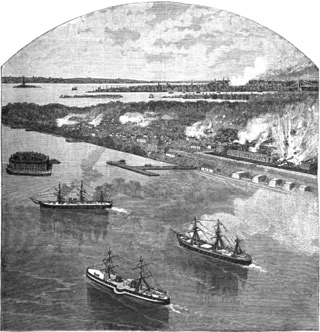|
“...the fascination of material prosperity [has] completely suppressed the martial spirit among us. During the last twenty years we have actually grown weaker… while almost every other maritime nation… has grown stronger”—so claimed an article on “Our Unprotected Seacoast” in the March 1887 issue of “Frank Leslie’s Popular Monthly.” The anxieties that provoked this and similar reports in the newspapers and magazines of the 1880s would soon lead to the first substantial fortifications on Davids Island.
Advances in Naval Warfare

Many nations modernized their navies in the last three decades of the 19th century. Steam replaced sail. Steel replaced cast iron and wood. Armaments became heavier and more deadly. The range of the largest naval guns steadily increased, reaching eight miles by the early 1880s. These weapons could be turned on ports and other targets on shore as easily as they could be used against ships.
The United States reacted slowly to these developments. Defense at sea was the responsibility of the Navy, but land-based coastal defense fell to the Army. The late 1860s through the 1870s was a period of great austerity for the Army, and it barely maintained America’s coastal forts, despite the rapid modernization of European navies. Only in 1885 did public alarm cause Congress to authorize the President to appoint a panel to review the situation.
This panel, the Board on Fortifications or Other Defenses, was chaired by Secretary of War William C. Endicott, and it was commonly called the Endicott Board. The panel issued its report in early 1886. Their report documented the inadequate state of the country’s coastal defenses and recommended construction of an extensive system of fortifications to protect the nation’s major ports.
Endicott-Era Defenses for the Port of New York
Once Congress accepted the board’s recommendations, the port of New York was among the first to receive attention from the Army. Both of its approaches had to be fortified. The main approach came from the south, passing through Lower New York Bay and the Verrazano Narrows. The eastern approach ran up Long Island Sound to the mouth of the East River at Throgs Neck.
To defend the immediate approaches to the East River, the Army decided to build new fortifications at Fort Schuyler on Throgs Neck to the north of the river’s mouth and at Fort Totten on Willets Point to the south. It also fortified Davids Island. The Army assigned this group of fortifications two missions:
- Preventing enemy ships in western Long Island Sound from shelling New York City; and
- Stopping warships from slipping down the East River into New York Harbor.
Construction of the coastal artillery batteries on Davids Island began in the early 1890s and continued for more than a decade. When completed, Fort Slocum’s fortifications had 20 seacoast mortars and medium-size guns in four batteries. The full group of batteries was in service for only a short while before being deactivated in 1906.
|




 Endicott Era
Endicott Era